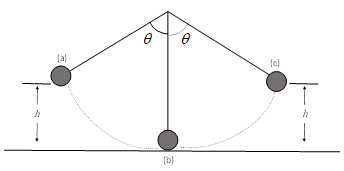
Concept explainers
Analyze the motion of a simple swinging pendulum in terms of energy, (a) ignoring friction, and (b) taking friction into account. Explain why a grandfather clock has to be wound up.
(a)
The motion of a simple swinging pendulum in terms of energy ignoring friction.
Answer to Problem 12Q
Solution:The pendulum reaches at point "c" the same height
Explanation of Solution
Given:Motion in terms of energy for a simple swinging pendulumignoring friction.
If there is no friction mechanical energy can be written as:
Or
Equation (2) can be written as:
Calculation:
A diagram of situation can be shown as follows:

Suppose that the pendulum is released from point a, its energy is entirely gravitational potential
Now, when pendulum ascends to point c the kinetic energy
Conclusion: Comparing equations (4) and (5) the pendulum reaches at point " c " the same height
(b)
To DetermineThe motion of a simple swinging pendulum in terms of energy taking friction into account. Why a grandfather clock has to be wound up.
Answer to Problem 12Q
Solution:The total mechanical energy is not constant in the system, for this reason, the grandfather clock is adjusted with the help of springs to compensate for the loss of energy by friction.
Explanation of Solution
Given:Motion in terms of energy for a simple swinging pendulum taking friction into account.
Formula used: If there is friction then, equation (3) must be written as:
In this case, part of the pendulum's kinetic and potential energy is transformed into thermal energy due to friction. As the oscillations advance, the kinetic and potential energy of the system is reduced until the pendulum stops completely. In the case of the grandfather clock, the same thing happens, for this reason, the watch is adjusted with the help of springs to compensate the energy lost by friction.
Conclusion:
The total mechanical energy is not constant in the system, for this reason, the grandfather clock is adjusted with the help of springs to compensate for the loss of energy by friction.
Chapter 6 Solutions
Physics: Principles with Applications
Additional Science Textbook Solutions
Physics for Scientists and Engineers: A Strategic Approach, Vol. 1 (Chs 1-21) (4th Edition)
College Physics
Lecture- Tutorials for Introductory Astronomy
University Physics (14th Edition)
The Cosmic Perspective Fundamentals (2nd Edition)
 College PhysicsPhysicsISBN:9781305952300Author:Raymond A. Serway, Chris VuillePublisher:Cengage Learning
College PhysicsPhysicsISBN:9781305952300Author:Raymond A. Serway, Chris VuillePublisher:Cengage Learning University Physics (14th Edition)PhysicsISBN:9780133969290Author:Hugh D. Young, Roger A. FreedmanPublisher:PEARSON
University Physics (14th Edition)PhysicsISBN:9780133969290Author:Hugh D. Young, Roger A. FreedmanPublisher:PEARSON Introduction To Quantum MechanicsPhysicsISBN:9781107189638Author:Griffiths, David J., Schroeter, Darrell F.Publisher:Cambridge University Press
Introduction To Quantum MechanicsPhysicsISBN:9781107189638Author:Griffiths, David J., Schroeter, Darrell F.Publisher:Cambridge University Press Physics for Scientists and EngineersPhysicsISBN:9781337553278Author:Raymond A. Serway, John W. JewettPublisher:Cengage Learning
Physics for Scientists and EngineersPhysicsISBN:9781337553278Author:Raymond A. Serway, John W. JewettPublisher:Cengage Learning Lecture- Tutorials for Introductory AstronomyPhysicsISBN:9780321820464Author:Edward E. Prather, Tim P. Slater, Jeff P. Adams, Gina BrissendenPublisher:Addison-Wesley
Lecture- Tutorials for Introductory AstronomyPhysicsISBN:9780321820464Author:Edward E. Prather, Tim P. Slater, Jeff P. Adams, Gina BrissendenPublisher:Addison-Wesley College Physics: A Strategic Approach (4th Editio...PhysicsISBN:9780134609034Author:Randall D. Knight (Professor Emeritus), Brian Jones, Stuart FieldPublisher:PEARSON
College Physics: A Strategic Approach (4th Editio...PhysicsISBN:9780134609034Author:Randall D. Knight (Professor Emeritus), Brian Jones, Stuart FieldPublisher:PEARSON





